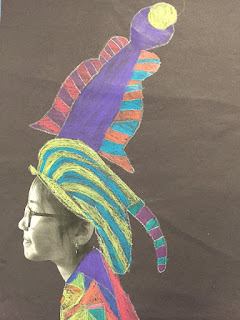 First grade students began the year by studying
how artists approach self-portraits. The
class read the book The Many Faces of the Face and described how all of
our faces are different, including their color, shape, and expression.
First grade students began the year by studying
how artists approach self-portraits. The
class read the book The Many Faces of the Face and described how all of
our faces are different, including their color, shape, and expression.
Students then created a collage
self-portrait by using a mirror and cut pieces of paper. The class then read another story by Ezra
Keats titled Jennie’s Hat. In the
book Jennie gets a hat from her aunt that she dislikes because it is too plain. At the end, birds come to decorate her hat
with all types of flowers and found materials, and Jennie is left with the most
beautiful hat she has ever seen.
Following the story students each created their own plain hat. We discussed different paper sculpture
techniques that they could use to decorate their hat and make it as special as
Jennies. Once the hat was complete
students added it to their self-portrait.

 First Grade students studied the Maya people of
Guatemala. We learned how this group of
people has retained many of their ancient customs and beliefs. The Maya also wear special clothing called
huipil. The Huipil are made by
weaving. Weaving, embroidery and sewing
help them to express themselves and their creativity. Designs often have special meaning. For example, families all have unique
patterns which are special to their village.
Students discussed how by wearing this style of dress the Maya have a
sense of belonging and show pride in their culture. We compared it to our own experiences of
feeling a sense togetherness and pride due to what we wear,when we thought of
our school uniforms and field day shirts.
We also explored how many cultures around the world have their own
special way of dressing.
First Grade students studied the Maya people of
Guatemala. We learned how this group of
people has retained many of their ancient customs and beliefs. The Maya also wear special clothing called
huipil. The Huipil are made by
weaving. Weaving, embroidery and sewing
help them to express themselves and their creativity. Designs often have special meaning. For example, families all have unique
patterns which are special to their village.
Students discussed how by wearing this style of dress the Maya have a
sense of belonging and show pride in their culture. We compared it to our own experiences of
feeling a sense togetherness and pride due to what we wear,when we thought of
our school uniforms and field day shirts.
We also explored how many cultures around the world have their own
special way of dressing. 
 Finally, we set out to create our own Huipiles. Students explored symmetry while cutting out
their shirt shape. Each child also
created a watercolor painting that experimented with different kinds of lines
which we cut up to include in our shirt design.
Students collaged different
papers to their art and added patterns.
Finally, we set out to create our own Huipiles. Students explored symmetry while cutting out
their shirt shape. Each child also
created a watercolor painting that experimented with different kinds of lines
which we cut up to include in our shirt design.
Students collaged different
papers to their art and added patterns.












































